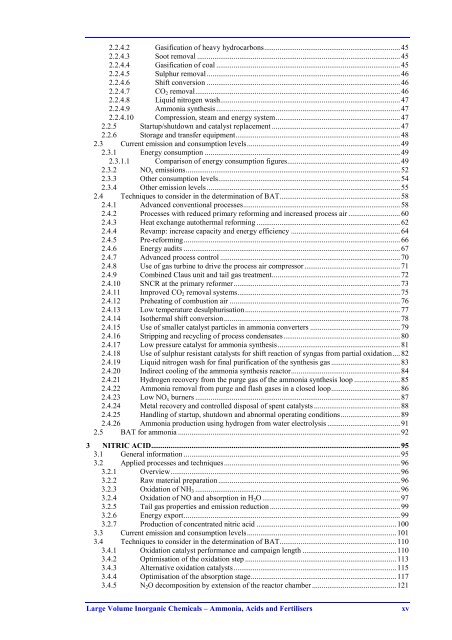Large Volume Inorganic Chemicals - Ammonia ... - ammk-rks.net
Large Volume Inorganic Chemicals - Ammonia ... - ammk-rks.net
Large Volume Inorganic Chemicals - Ammonia ... - ammk-rks.net
- No tags were found...
You also want an ePaper? Increase the reach of your titles
YUMPU automatically turns print PDFs into web optimized ePapers that Google loves.
2.2.4.2 Gasification of heavy hydrocarbons....................................................................... 452.2.4.3 Soot removal .......................................................................................................... 452.2.4.4 Gasification of coal ................................................................................................ 452.2.4.5 Sulphur removal..................................................................................................... 462.2.4.6 Shift conversion ..................................................................................................... 462.2.4.7 CO 2 removal........................................................................................................... 462.2.4.8 Liquid nitrogen wash.............................................................................................. 472.2.4.9 <strong>Ammonia</strong> synthesis ................................................................................................ 472.2.4.10 Compression, steam and energy system................................................................. 472.2.5 Startup/shutdown and catalyst replacement ................................................................... 472.2.6 Storage and transfer equipment...................................................................................... 482.3 Current emission and consumption levels................................................................................ 492.3.1 Energy consumption ...................................................................................................... 492.3.1.1 Comparison of energy consumption figures........................................................... 492.3.2 NO x emissions................................................................................................................ 522.3.3 Other consumption levels............................................................................................... 542.3.4 Other emission levels ..................................................................................................... 552.4 Techniques to consider in the determination of BAT............................................................... 582.4.1 Advanced conventional processes.................................................................................. 582.4.2 Processes with reduced primary reforming and increased process air ........................... 602.4.3 Heat exchange autothermal reforming ........................................................................... 622.4.4 Revamp: increase capacity and energy efficiency ......................................................... 642.4.5 Pre-reforming................................................................................................................. 662.4.6 Energy audits ................................................................................................................. 672.4.7 Advanced process control .............................................................................................. 702.4.8 Use of gas turbine to drive the process air compressor.................................................. 712.4.9 Combined Claus unit and tail gas treatment................................................................... 722.4.10 SNCR at the primary reformer....................................................................................... 732.4.11 Improved CO 2 removal systems..................................................................................... 752.4.12 Preheating of combustion air ......................................................................................... 762.4.13 Low temperature desulphurisation................................................................................. 772.4.14 Isothermal shift conversion............................................................................................ 782.4.15 Use of smaller catalyst particles in ammonia converters ............................................... 792.4.16 Stripping and recycling of process condensates............................................................. 802.4.17 Low pressure catalyst for ammonia synthesis................................................................ 812.4.18 Use of sulphur resistant catalysts for shift reaction of syngas from partial oxidation.... 822.4.19 Liquid nitrogen wash for final purification of the synthesis gas .................................... 832.4.20 Indirect cooling of the ammonia synthesis reactor......................................................... 842.4.21 Hydrogen recovery from the purge gas of the ammonia synthesis loop ........................ 852.4.22 <strong>Ammonia</strong> removal from purge and flash gases in a closed loop.................................... 862.4.23 Low NO x burners ........................................................................................................... 872.4.24 Metal recovery and controlled disposal of spent catalysts ............................................. 882.4.25 Handling of startup, shutdown and abnormal operating conditions............................... 892.4.26 <strong>Ammonia</strong> production using hydrogen from water electrolysis ...................................... 912.5 BAT for ammonia .................................................................................................................... 923 NITRIC ACID.................................................................................................................................. 953.1 General information ................................................................................................................. 953.2 Applied processes and techniques............................................................................................ 963.2.1 Overview........................................................................................................................ 963.2.2 Raw material preparation............................................................................................... 963.2.3 Oxidation of NH 3 ........................................................................................................... 963.2.4 Oxidation of NO and absorption in H 2 O........................................................................ 973.2.5 Tail gas properties and emission reduction .................................................................... 993.2.6 Energy export................................................................................................................. 993.2.7 Production of concentrated nitric acid ......................................................................... 1003.3 Current emission and consumption levels.............................................................................. 1013.4 Techniques to consider in the determination of BAT............................................................. 1103.4.1 Oxidation catalyst performance and campaign length ................................................. 1103.4.2 Optimisation of the oxidation step ............................................................................... 1133.4.3 Alternative oxidation catalysts..................................................................................... 1153.4.4 Optimisation of the absorption stage............................................................................ 1173.4.5 N 2 O decomposition by extension of the reactor chamber ............................................ 121<strong>Large</strong> <strong>Volume</strong> <strong>Inorganic</strong> <strong>Chemicals</strong> – <strong>Ammonia</strong>, Acids and Fertilisersxv
















